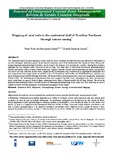Mapping of coral reefs in the continental shelf of Brazilian Northeast through remote sensing
Resumo
The Continental Shelf has great importance in the study of coastal evolution, provided this area was affected by fluctuations in sea level during the Quaternary period. In the shallow continental shelf of the Northeastern Rio Grande do Norte, Brazil, submerged important geomorphological features can be found in the distance of 6 km from the coastline. Among these features, highlights the reef complex called Parrachos of Rio do Fogo. This study aims to characterize and analyze geomorphological features and benthic surface features found in this reef complex, from the analysis and interpretation of remote sensing products and in situ data collection. In this work, a digital model of bathymetry was created based on unpublished bathymetric data and compositions from images bands of satellite sensors OLI/Landsat-8, MS/GeoEye and PAN/WordView-1, and then analyzed, interpreted and validated through field work. All obtained data and information were stored in a Geographic Information System (GIS). The following geoenvironmental units were mapped: intertidal reefs, submerged reefs, spurs and grooves, pools, sandy bank, sea grasses, bank of algaes, submerged roads, Barreta Channel and the Rio do Fogo Channel. The use of the proposed methodology provided a detailed analysis of submerged geomorphology in the study area. This study may be used as a guide for future decision-making for environmental management in the region.




